OBWG PSD2 PIS
OBWG PSD2 PIS APIs
API Name | API Endpoint | API Description |
Domestic Payment Create | POST /domestic-payment-consents | Create domestic payment consents |
Domestic Payment Submit | POST /domestic-payments | Submits a created domestic payment |
Domestic Payment Detail | GET /domestic-payment-consents/{ConsentId} | Returns the details of created domestic payment |
Domestic Payment Create Status | GET /domestic-payment-consents/{ConsentId}/status | Returns the status of created domestic payment |
Domestic Payment Submit Details | GET /domestic-payments/{DomesticPaymentId} | Returns the details of a submitted domestic payment |
Domestic Payment Submit Status | GET /domestic-payments/{DomesticPaymentId}/status | Returns the status of a submitted domestic payment |
Domestic Scheduled Payment Create | POST /domestic-scheduled-payment-consents | Create domestic dcheduled payment consents |
Domestic Scheduled Payment Submit | POST /domestic-scheduled-payments | Submits a created domestic scheduled payment |
Domestic Scheduled Payment Details | GET /domestic-scheduled-payment-consents/{ConsentId} | Returns the details of created domestic scheduled payment |
Domestic Scheduled Payment status | GET /domestic-scheduled-payment-consents/{ConsentId}/status | Returns the status of created domestic scheduled payment |
Domestic Scheduled Payment Submit Details | GET /domestic-scheduled-payments/{DomesticScheduledPaymentId} | Returns the details of a submitted domestic scheduled payment |
Domestic Scheduled Payment Submit Status | GET /domestic-scheduled-payments/{DomesticScheduledPaymentId}/status | Returns the status of a submitted domestic scheduled payment |
OAuth SCA
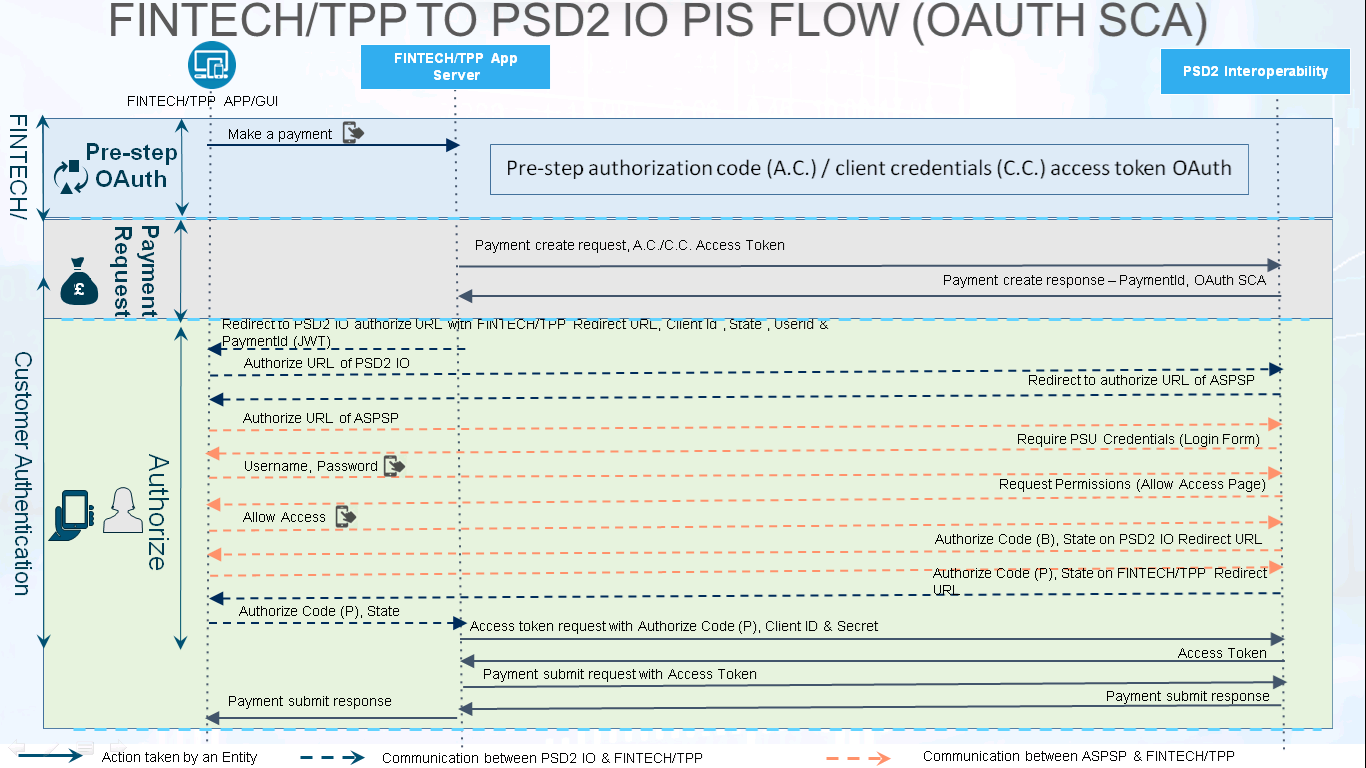
Step 1: Pre-step OAuth
- PSU will request to make a payment.
- Depends on destination bank, TPP has to do a pre-step authorization_code (A.C.) / client_credentials (C.C.) access token Oauth.
Step 2: Create Payment-Consent
- Fintech / TPP will send the payment-consent request with A.C / C.C. access token to PSD2 IO.
- PSD2 IO will return response containing ConsentId, OAuth SCA approach to Fintech / TPP.
Step 3: Authorize
- Fintech / TPP will redirect PSU to ‘/authorize’ URL with TPP Redirect URL,Client Id, State, UserId & ConsentId in JWT to authenticate the request id from PSU.
- PSU will get redirected to PSD2 IO authorize URL through the browser.
- PSD2 IO will redirect PSU to ASPSP authorize URL through the browser.
- ASPSP will redirect PSU to the login page for authentication.
- PSU has to authenticate with his credentials on ASPSP’s login page.
- Once authenticated, ASPSP will ask to allow access for authorization.
- PSU will allow access.
- ASPSP will return auth code (B) & state on the callback URL of PSD2 IO.
- PSD2 IO will return auth code (P) & state on the callback URL of Fintech / TPP.
Step 4: Access Token
- Fintech / TPP will call the ‘/token’ API of PSD2 IO with auth code (P) received on callback.
- PSD2 IO will return the access token to Fintech / TPP.
Step 5: Submit Payment
This step needs to be exceuted only if value of PaymentFlow field in GET /banks API is TwoStep.
- Fintech / TPP will call payment submit API using the access token received.
- PSD2 IO will give the response to Fintech / TPP.
- Fintech / TPP will show the response to PSU on TPP UI.
Redirect SCA
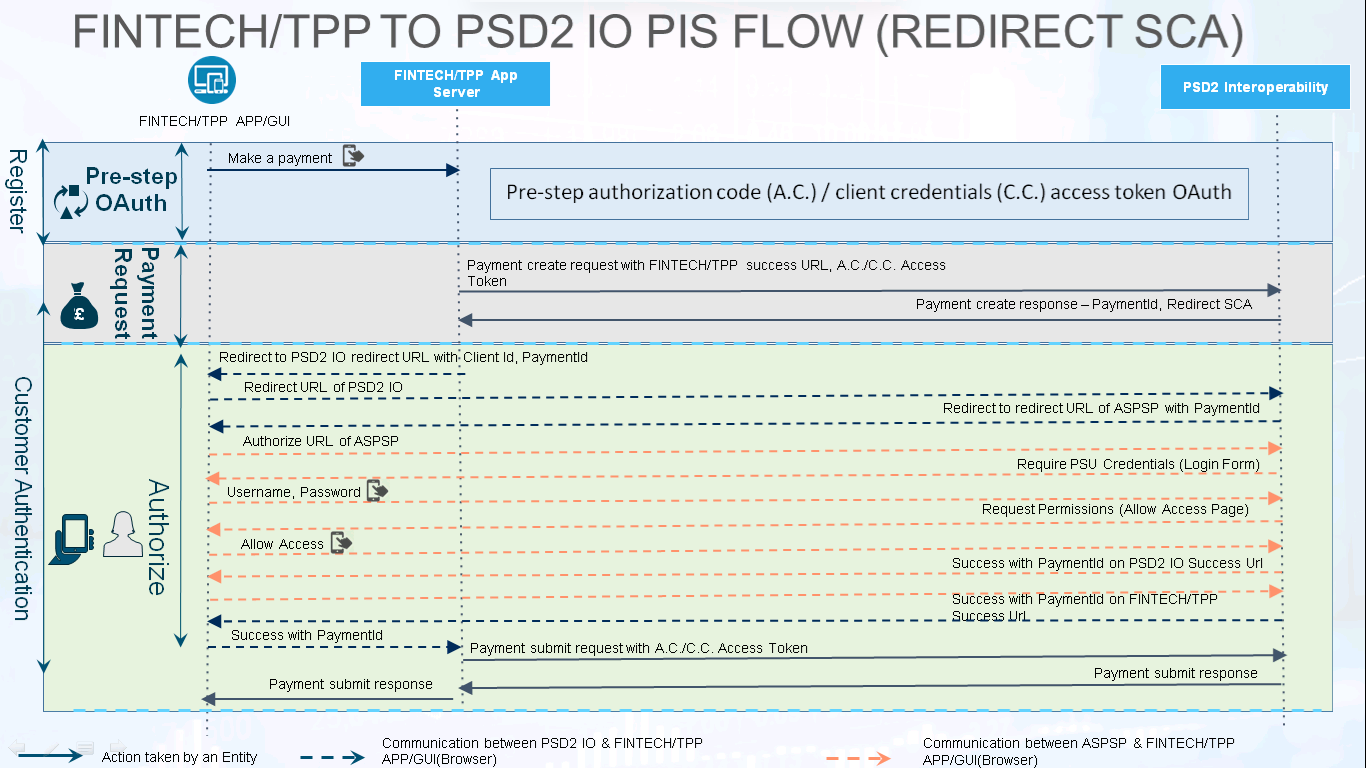
Step 1: Pre-step OAuth
- PSU will request to make a payment.
- Depends on destination bank, TPP has to do a pre-step authorization_code (A.C.) / client_credentials (C.C.) access token Oauth.
Step 2: Create Payment-Consent
- Fintech / TPP will send the payment-consent request with A.C / C.C. access token to PSD2 IO.
- PSD2 IO will return response containing ConsentId, OAuth SCA approach to Fintech / TPP.
Step 3: Redirect
- Fintech / TPP will redirect PSU to ‘/redirect’ URL with Client Id, ConsentId to authenticate the ConsentId from PSU.
- PSU will get redirected to PSD2 IO redirect URL through browser.
- PSD2 IO will redirect PSU to ASPSP redirect URL through browser.
- ASPSP will redirect PSU to login page for authentication.
- PSU has to authenticate with his credentials on ASPSP’s login page.
- Once authenticated, ASPSP will ask to allow access for authorization.
- PSU will allow access.
- ASPSP will return success along with ConsentId on the success URL of PSD2 IO.
- PSD2 IO will return success along with ConsentId on the success URL of Fintech / TPP.
Step 4: Submit Payment
This step needs to be exceuted only if value of PaymentFlow field in GET /banks API is TwoStep.
- Fintech / TPP will call payment submit API using the A.C./C.C access token received.
- PSD2 IO will give the response to Fintech / TPP.
- Fintech / TPP will show the response to PSU on TPP UI.
Embedded SCA
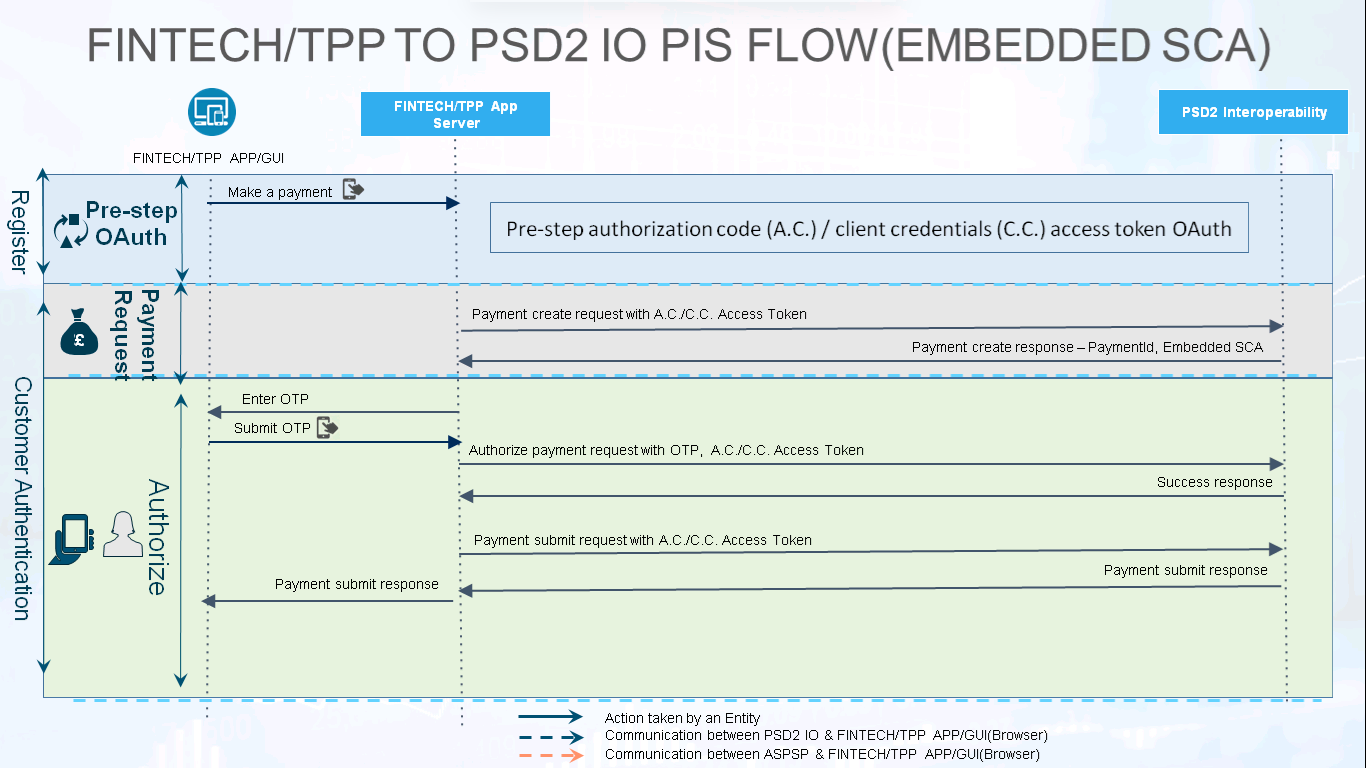
Step 1: Pre-step OAuth
- PSU will request to make a payment.
- Depends on destination bank, TPP has to do a pre-step authorization_code (A.C.) / client_credentials (C.C.) access token Oauth.
Step 2: Create Payment-Consent
- Fintech / TPP will send the payment-consent request with A.C / C.C. access token to PSD2 IO.
- PSD2 IO will return response containing ConsentId, OAuth SCA approach to TPP.
Step 3: Embedded SCA
- Fintech / TPP will ask PSU to provide answer of the challenge received in the payment create response. Here for e.g.: OTP is taken.
- PSU will enter and submit the challenge data e.g.: OTP
- TPP will call authorize payment API with the A.C./C.C. access token, challenge data e.g. OTP.
- PSD2 IO will give the response to Fintech / TPP.
Step 4: Submit Payment
This step needs to be exceuted only if value of PaymentFlow field in GET /banks API is TwoStep.
- Fintech / TPP will call payment submit API using the A.C./C.C access token received.
- PSD2 IO will give the response to TPP.
- Fintech / TPP will show the response to PSU on Fintech / TPP UI.
Embedded SCA with SCA Method Selection
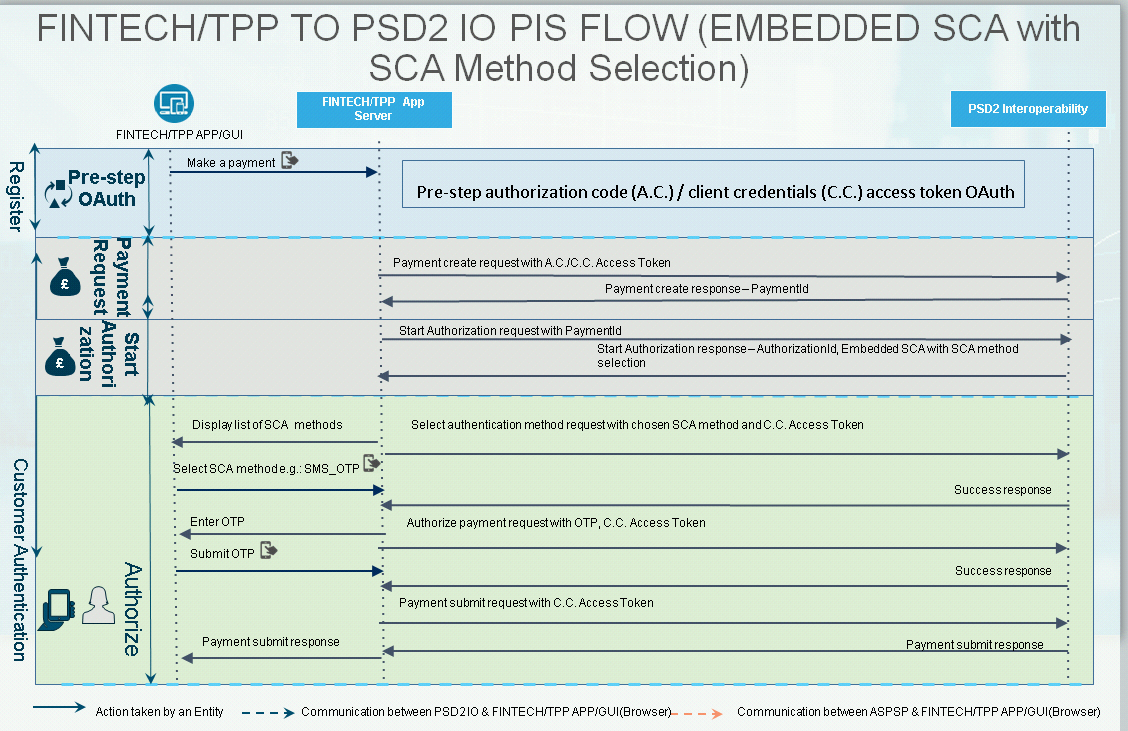
Step 1: Pre-step OAuth
- PSU will request to make a payment.
- Depends on destination bank, TPP has to do a pre-step authorization_code (A.C.) / client_credentials (C.C.) access token Oauth.
Step 2: Create Payment-Consent
- Fintech / TPP will send the payment-consent request with A.C / C.C. access token to PSD2 IO.
- PSD2 IO will return response containing ConsentId, OAuth SCA approach to Fintech / TPP.
Step 3: Start Authorization
- Fintech/TPP will send the start Authorization request with ConsentId to PSD2 IO.
- PSD2 IO will return response containing AuthorizationId with SCA method selection to Fintech/TPP.
Step 4: Embedded SCA with SCA Method Selection
- Fintech / TPP will ask PSU to select SCA method out of those received in the response.
- PSU will select the SCA method.
- Fintech / TPP will call select authentication API using the A.C./C.C. access token and selected SCA method.
- PSD2 IO will give the response to Fintech / TPP.
- Fintech / TPP will ask PSU to provide answer of the challenge received in the select authentication API response. Here for e.g.: OTP is taken.
- PSU will enter and submit the challenge data e.g.: OTP
- Fintech / TPP will call authorize payment API with the A.C./C.C. access token, challenge data e.g. OTP.
- PSD2 IO will give the response to TPP.
Step 5: Submit Payment
This step needs to be exceuted only if value of PaymentFlow field in GET /banks API is TwoStep.
- Fintech / TPP will call payment submit API using the A.C./C.C access token received.
- PSD2 IO will give the response to TPP.
- Fintech / TPP will show the response to PSU on TPP UI.
Decoupled SCA
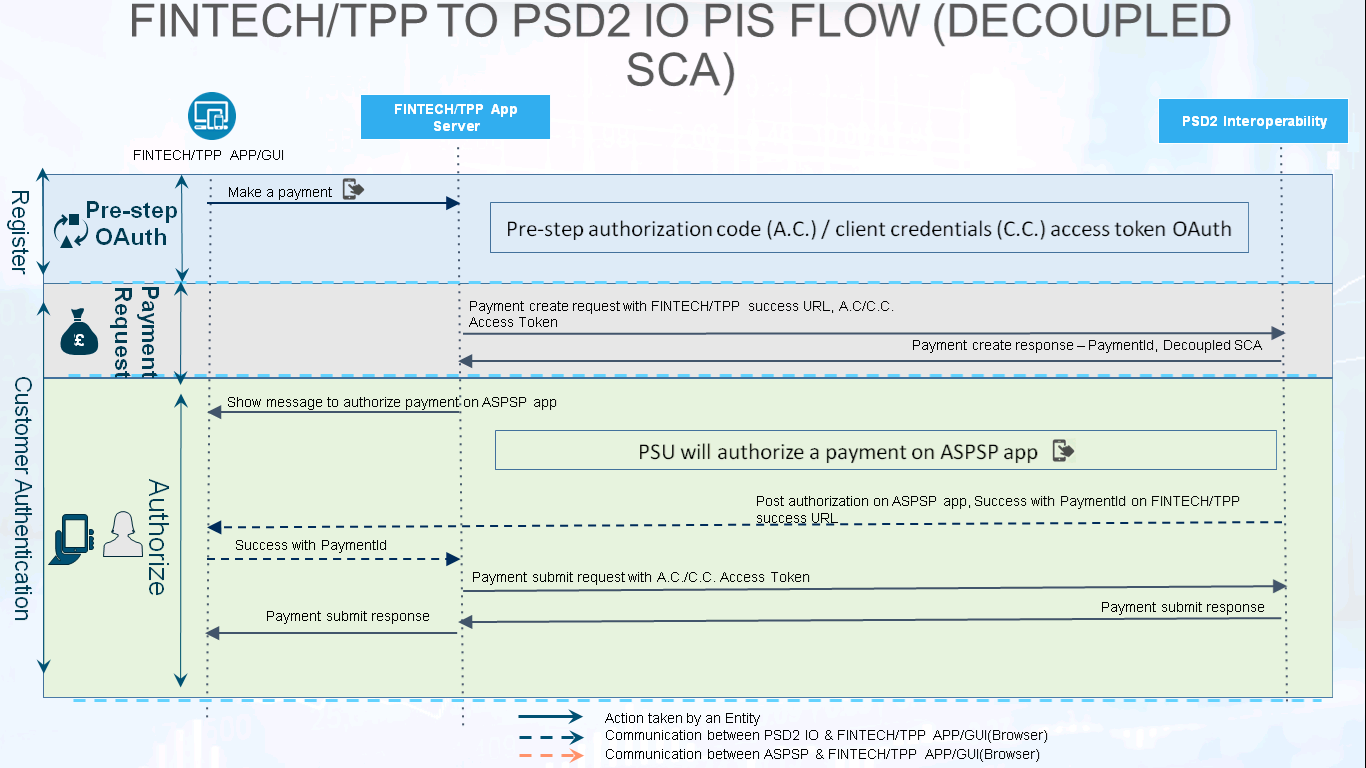
Step 1: Pre-step OAuth
- PSU will request to make a payment.
- Depends on destination bank, TPP has to do a pre-step authorization_code (A.C.) / client_credentials (C.C.) access token Oauth.
Step 2: Create Payment-Consent
- Fintech / TPP will send the payment-consent request with A.C / C.C. access token to PSD2 IO.
- PSD2 IO will return response containing consentId, OAuth SCA approach to Fintech / TPP.
Step 3: Authorize payment on ASPSP application
- Fintech / TPP will show the message to PSU to authorize the payment on ASPSP application.
- PSU will authorize the payment on the ASPSP application.
- PSD2 IO will return success along with ConsentId on the success URL of Fintech / TPP.
Step 4: Submit Payment
This step needs to be exceuted only if value of PaymentFlow field in GET /banks API is TwoStep.
- Fintech / TPP will call payment submit API using the A.C./C.C access token received.
- PSD2 IO will give the response to Fintech / TPP.
- Fintech / TPP will show the response to PSU on Fintech / TPP UI.
Decoupled SCA with Update Identification
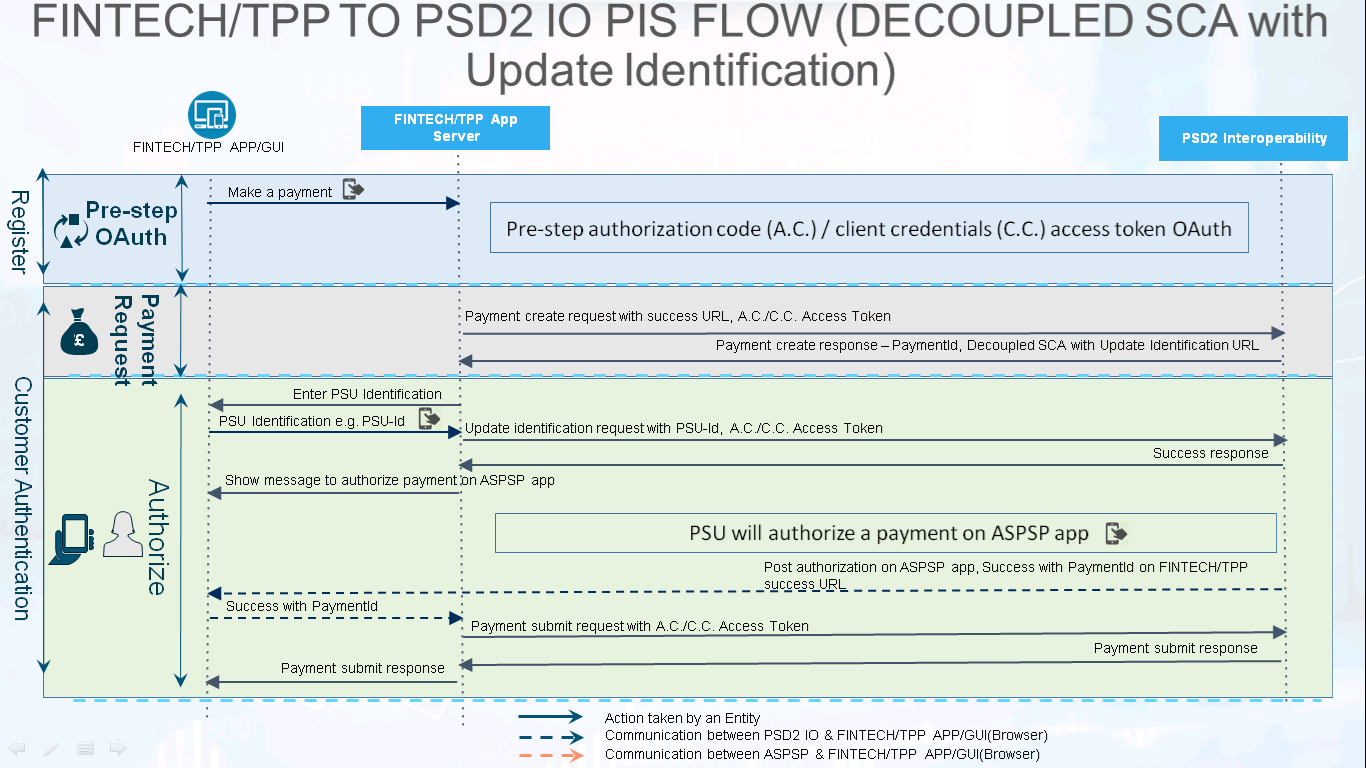
Step 1: Pre-step OAuth
- PSU will request to make a payment.
- Depends on destination bank, TPP has to do a pre-step authorization_code (A.C.) / client_credentials (C.C.) access token Oauth.
Step 2: Account Access Consent Request
- Fintech / TPP will send the payment-consent request with A.C / C.C. access token to PSD2 IO.
- PSD2 IO will return response containing ConsentId, OAuth SCA approach to Fintech / TPP.
Step 3: Decoupled SCA with Update Identification
- PP will ask PSU to update his identification data.
- PSU will enter his identification data e.g. PSU-Id.
- Fintech / TPP will call update identification API with the PSU identification data, C.C. access token
- PSD2 IO will give the response to Fintech / TPP.
Step 4: Authorize payment on ASPSP application
- Fintech / TPP will show the message to PSU to authorize the payment on ASPSP application.
- PSU will authorize the payment on the ASPSP application.
- PSD2 IO will return success along with ConsentId on the success URL of Fintech / TPP.
Step 5: Submit Payment
This step needs to be exceuted only if value of PaymentFlow field in GET /banks API is TwoStep.
- Fintech / TPP will call payment submit API using the A.C./C.C access token received.
- PSD2 IO will give the response to Fintech / TPP.
- Fintech / TPP will show the response to PSU on Fintech / TPP UI.
